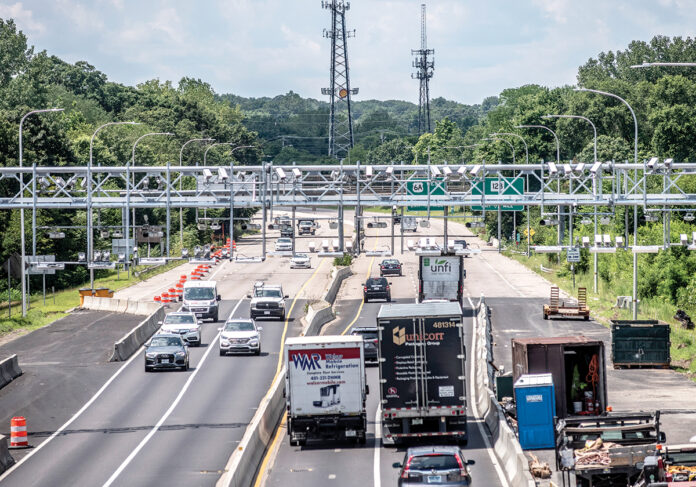Coming to a Rhode Island highway near you: “Big Brother,” electronic truck-tolling style.
That may be a cynical way to describe the automated truck-tolling gantries that the R.I. Department of Transportation is putting up around Rhode Island, though truckers probably wouldn’t think so.
The American Trucking Associations so far has unsuccessfully sued the department to stop it.
The system tolls large trailer trucks – those in classes 8 through 13, generally those used for commercial trucking. The maximum toll for a truck passing through Rhode Island is $20 one way, although many of the tolls will be less than that.
The system was created to raise money for state bridge repairs and maintenance, and perhaps eventually for other transportation department projects.
Consider the Orwellian nature of each gantry, outfitted with five or six different pieces of surveillance equipment, which the department admits is “fully redundant” – but for good reason.
The collection of overhead contraptions is designed to make it extra difficult for truckers to elude the system.
First, there’s an antenna that picks up signals from transponders in approaching vehicles for the state’s “E-ZPass” pre-paid toll program. That alone picks up 80-90% of the commercial truck traffic passing under the gantries, said Peter Alviti Jr., the department’s director.
Second, there’s an infrared illuminator. Not visible to the naked eye, it makes license plates on passing trucks more visible for the system.
Third, there’s a front camera, so named because it reads the front license plates of approaching traffic.
Fourth, there’s a video camera that identifies and classifies each type of vehicle.
Finally, there’s an “overview” camera for “manual classification” of vehicles in case all else fails. Images of vehicles are transmitted to a remote location where inspectors check them to identify and classify any vehicles that might have slipped through the system.
‘[Kapsch plans] to … help make the RhodeWorks program a reality.’
CHRIS MURRAY, Kapsch TrafficCom North American president
To ensure that all tractor-trailers traveling on highway locations supported by bridges are tolled, the various pieces of gantry equipment are positioned to pick up vehicles in each lane, the shoulders of the road, and even nearby exit ramps.
Classification of different types and sizes of trucks is a key part of the system, as it is used to determine the tolling rates for various vehicles. The R.I. Turnpike and Bridge Authority handles the billing.
The transportation department says some of the technology has its roots in the U.S. Department of Defense.
A transportation department report states each gantry will be equipped with “next-generation video detection and classification” that “locks onto vehicles and tracks them through the zone, based on missile-tracking algorithms. … Vehicle shape and axel count determine classification.”
The different components “are used to determine the class of vehicle, the type of vehicle, and the billable owner,” Alviti said.
So far, two truck-tolling gantries on Interstate 95 in southern Rhode Island have been in operation. A third on Route 6 over the Woonasquatucket River in Providence is scheduled to begin operating this month.
Overall, there will be 13 new gantries, all scheduled to go into operation by next April. They will be located on I-95, Interstate 295, Interstate 195, Route 146, Route 10 and Route 6.
All but two of the gantries will be clustered in and around Providence, from Woonsocket to Warwick, according to a project map.
The total cost of the project is about $68 million. When all 13 gantries are operating, they are expected to generate about $45 million a year in tolls.
Minus about $4 million a year in operating costs, the program is expected to net the state $41 million annually for bridge repairs and maintenance under the state’s RhodeWorks transportation-infrastructure improvement program.
For legal purposes, each of the gantries will be located on a spot on a highway supported by a bridge – either over another road, a waterway, or other terrain. The tolls generated by each gantry are being dedicated for the repair or replacement of the bridges where each one will be located.
Alviti said the U.S. District Court in Rhode Island has ruled in favor of the state in response to the truckers’ lawsuit challenging the legality of the tolling system, but the plaintiffs are appealing the decision.
Representatives for the American Trucking Associations did not respond to requests for comment. In addition, Cumberland Farms Inc., M&M Transport Services Inc., and New England Motor Freight joined the suit.
The state "has successfully argued that tolls are a tax and therefore the merits of the case - the legality and constitutionality - should be heard in state court. This venue would clearly favor them," said Chris Maxwell, president and CEO of the Rhode Island Trucking Association.
"The American Trucking Associations and its co-plaintiffs are appealing this decision in the First Circuit [Court] and believe the proper venue for this to be heard is in federal court," Maxwell said.
Although each tolling gantry has numerous components, assembly can be done in relatively little time, Alviti said. The components are installed on the roadside, often at night, fastened to steel girders that compose the gantries.
Each fully loaded gantry is then lifted over the roadway by crane and bolted to uprights over the road. The gantries stretch across all traffic lanes, like a typical highway sign. Lane closures only last about 30 minutes to put up each gantry.
In 2017, Kapsch TrafficCom, an Australian multinational traffic-management and tolling systems company, was awarded a $68.9 million contract with the state to design, install, operate and maintain the truck-tolling system.
“Kapsch is excited to be selected by Rhode Island to provide their statewide truck-tolling system,” said Chris Murray, president of Kapsch TrafficCom North America. The company plans “to successfully deliver this system and help make the RhodeWorks program a reality,” he said.
Scott Blake is a PBN staff writer. Contact him at Blake@PBN.com.












